Just when we thought we were finally putting the pandemic behind us, new COVID-19 variants like Delta and Lambda emerged. A global supply chain snarl led to delays with Costco inventory and Amazon shipping speeds. Some countries have already reinstituted travel restrictions.
But make no mistake—business travel spending is still increasing.
In fact, according to the Global Business Travel Association’s annual BTI Outlook report, travel spending is expected to increase by 21% in the second half of 2021. And according to American Airlines Group, 47 of the airline’s 50 largest corporate accounts plan to resume business travel this year.
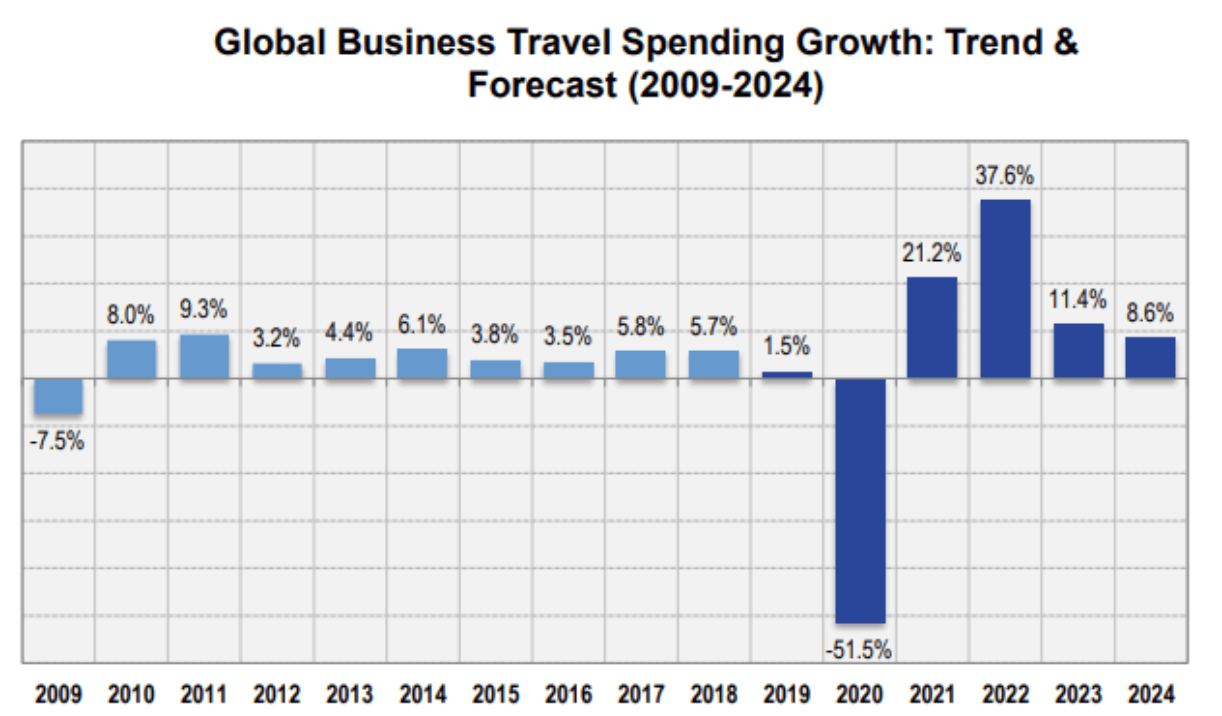
That being said, corporate travel is still 70% or more below pre-pandemic levels. While the GBTA expects a significant rebound in international business travel and meeting activity in 2022, they don’t expect business travel to return to pre-pandemic levels until 2025.
The silver lining is that there’s plenty of time for travel and expense (T&E) managers to rethink how they deploy budget as we prepare for business travel to ramp up in 2022 and beyond. Here are eight ways companies can adapt to the new financial landscape for T&E management:
1. Rethink what duty of care means for your organization
The World Health Organization (WHO) published its Pandemic Fatigue guide at the end of 2020. Unsurprisingly, the WHO included extensive guidance on how employers should navigate employee and business travel. Suddenly, duty of care policies took center stage. COVID-19 had hit a nerve with everyone, especially business travelers and travel managers.
Our current disbursed travel model challenges duty of care leaders and decision-makers to completely rethink what duty of care means for their organizations. Even outside of planned business travel, more employees—especially remote workers—will become frequent travelers.
Knowing where your employees are in a remote or hybrid work model matters a great deal, especially during a pandemic.
According to Emburse’s 2021 Travel & Expense Management Trends report, 42% of organizations expect increased duty of care costs in the coming years due to a variety of factors, including pandemic cleanliness protocols, employee safety considerations, new government regulations for business travel, and more flexible booking/rebooking requirements.
The growing desire on the part of conscientious organizations to manage costs and lower their carbon footprint and environmental impact also play into duty of care considerations.
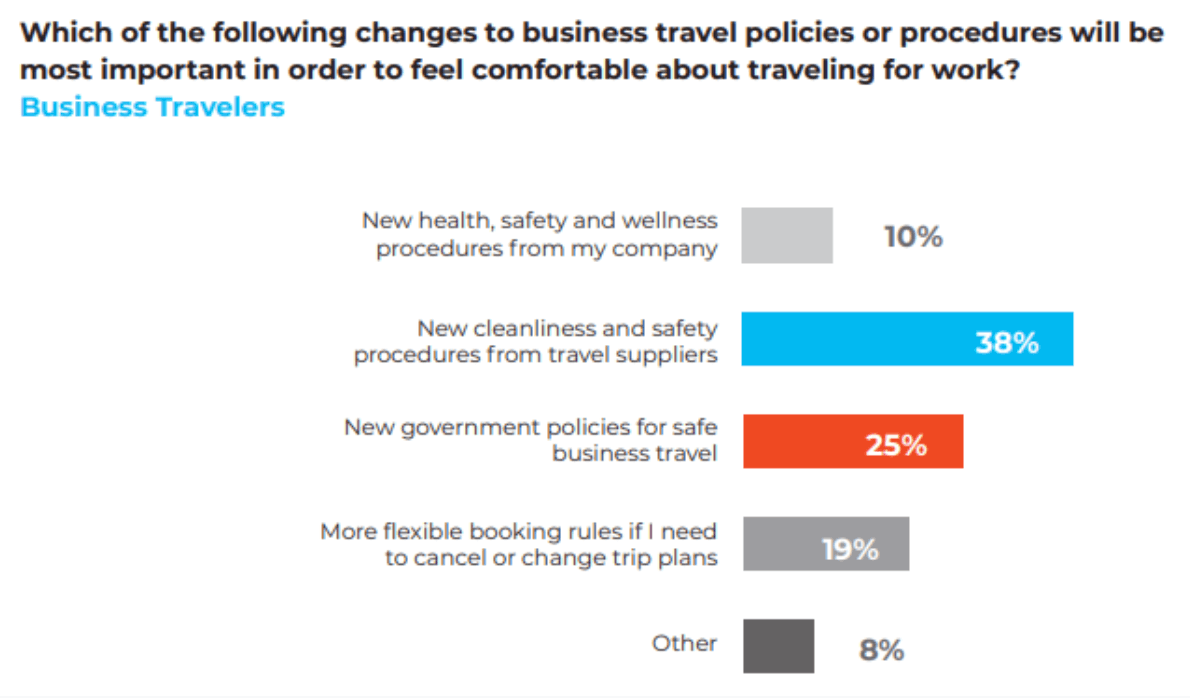
But duty of care doesn’t have to be another hurdle travel managers need to jump through. In fact, it could actually open up potential avenues for cost savings.
To better ensure that your employees are staying compliant while traveling, consider implementing a preapproval process for all domestic and international travel if you haven’t already. Many companies may have to revisit HR policies and internal processes to ensure remote worker safety (and organizational security).
Additionally, organizations could get better about issuing virtual credit cards with built-in limits, or potentially limit traveler expense categories on a trip-by-trip and location-by-location basis.
2. Update all T&E policies to reflect remote work trends
The rapid rise in remote and hybrid work models means that many organizations have more remote workers than in-person employees at this point. But they haven’t necessarily updated their T&E policies to match their new reality.
Of course, travel managers are in charge of more than international or domestic business trips. T&E budgets may also include day-to-day travel to and from the office, collaboration spaces, and local meeting venues.
In PwC’s most recent US Remote Work Survey (a report on hybrid workforces), 55% of executives expect that 60% or more of employees will continue working remotely after the pandemic subsides. In other words, updating T&E policies to account for an increasing number of remote and hybrid workers is just smart business.
Fortunately, PwC’s Strategy& team came up with this handy Employee Mobility Model to give employers an easy-to-use guide on the number of recommended in-person vs. remote work hours to give each type of employee:
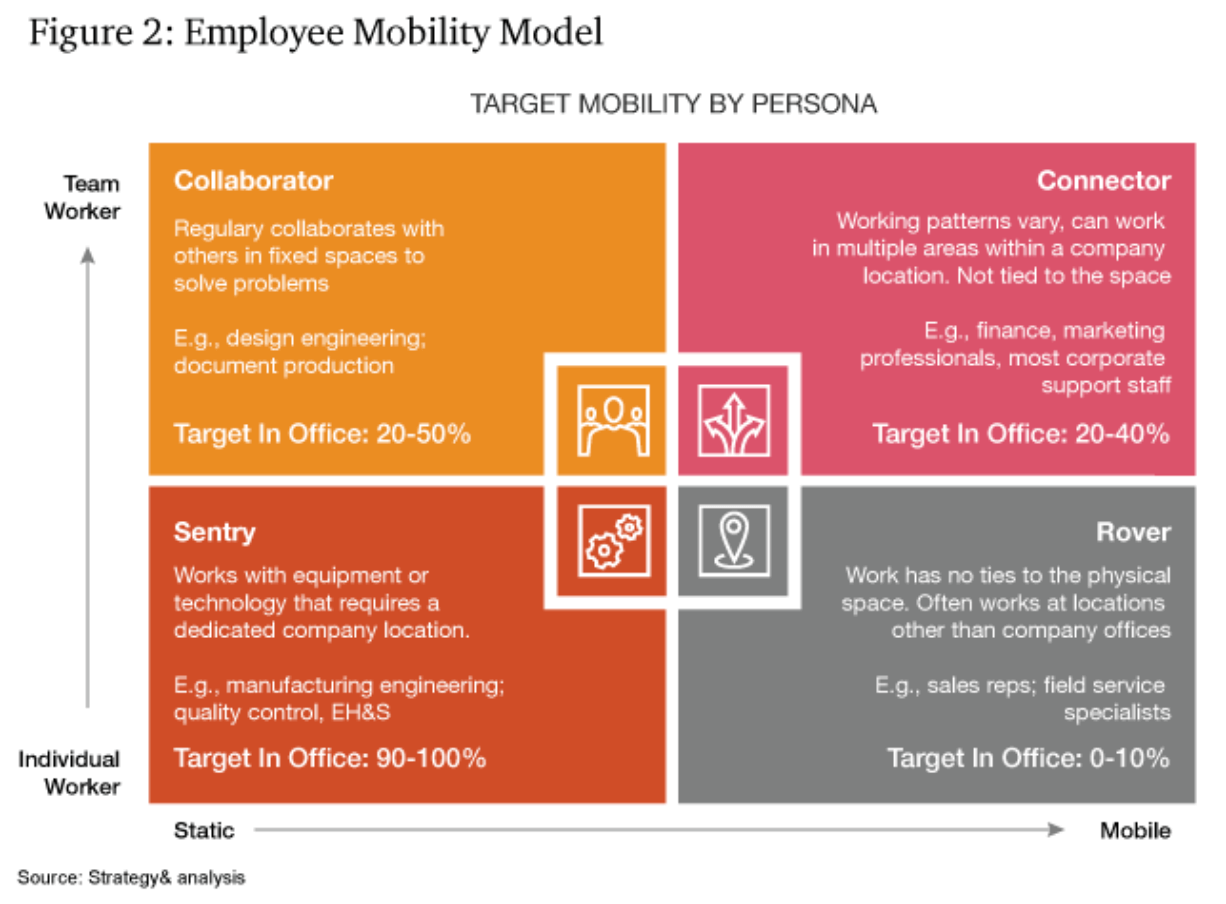
PwC divides employees into four types: Collaborators, who work in teams to solve strategic problems; Connectors, like admin and support staff; Sentries, who might work in QA or operate machinery; and Rovers, workers who can operate anywhere, such as sales reps or service technicians.
Collaborator T&E Considerations:
- Some travel to the office (20–50%)
- Offsite collaboration space
- Travel dependent on team location
Connector T&E Considerations:
- Some travel to the office (20–40%)
- Might travel between offices
- Some offsite collaboration travel and expenses
Sentry T&E Considerations:
- Heavy travel to the office or work location (90–100%)
- More predictable travel and expense patterns
- Travel not dependent on team location
Rover T&E Considerations:
- Heavy travel to multiple locations (0–10% in office)
- Less predictable travel and expense patterns
- Travel dependent on customer/prospect locations
3. Issue virtual cards to better control and track spending
Speaking of updating T&E policies, are you using virtual cards yet? According to the 2020 Deem Technology Spotlight, travel manager program goals over the next few years into 2023 are to:
- Gain a unified view of spending: Simplify expense, travel, and invoice management in an integrated solution for visibility and greater control.
- Ensure policy leads the way: Ensure that clear, well-thought-out policies and procedures are in place around T&E expenses.
- Remember T&E is about people: Foster a culture of compliance with easy tools to help employees stay within policy.
- Use automation to improve compliance: Impose payment controls, eliminate mistakes, and speed audits with smart automation.
Fortunately, virtual cards help with all of the above. Here are the main benefits of issuing virtual cards over physical cards not just for business travelers, but all of your employees:
Virtual card advantages
- Cannot be lost, misplaced, damaged, or stolen
- No need (or cost) to replace them; no delays for employees
- Can be easily accessed and used on the go via smartphones
- Can be easily programmed for compliant spending with spending limits that work only within a certain timeframe, only with approved vendors, and only for key employees
Physical card disadvantages
- Can be lost, misplaced, damaged, and/or stolen
- Risk vector with a short window for cancellation
- Lost or stolen cards lead to delays for business travelers and key employees
- Very little control over spending, easier for employees to incur out-of-policy spending or to commit transaction fraud
According to Wired and Conde Nast Traveler, virtual cards also make plenty of business sense because smartphones are already the preferred method of payment for corporate travelers, as well as the preferred method for finance teams to keep track of employee expenses.
Modern expense management apps automatically categorize expense details when receipts are scanned—no need for paper. Digital receipts are centralized and updated 24/7, allowing T&E managers and AP teams to track spending in real-time.
4. Improve productivity by speeding up expense report processing
In 2021 and beyond, a more cost-conscious T&E department will require flexible, agile solutions that reduce friction and increase operational efficiencies. Choosing the right systems with scalable automation and company-wide usability is mission-critical.
As an example, while many organizations can process expense reports within a day, nearly one-third of respondents in Emburse’s 2021 Travel & Expense Management Trends report stated that their organization takes 8+ days to approve and reimburse an expense report.
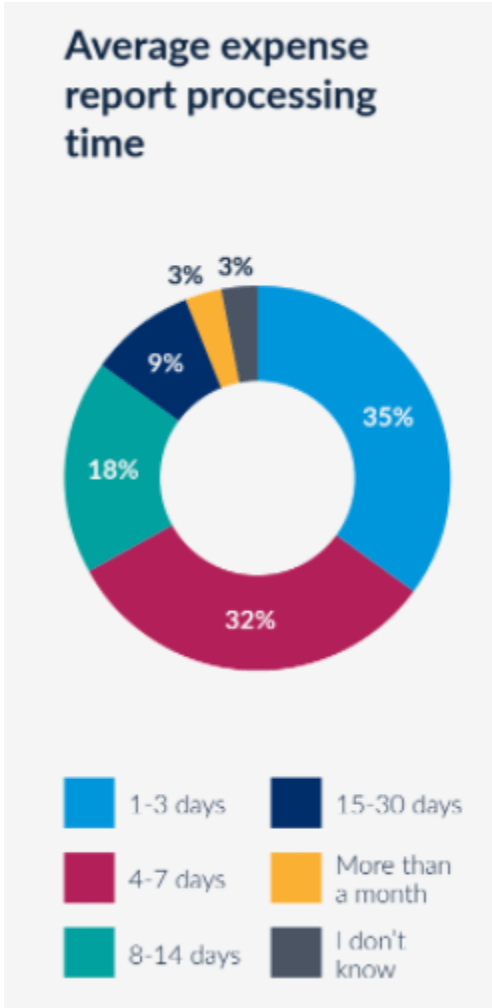
It goes without saying that delays in approving or reimbursing expenses can lead to significant employee and vendor frustration. Slow chargebacks to clients, difficulty forecasting cashflows, and budget overruns are also common problems when expense report approvals are bottlenecked.
Manual report processing is a big contributor to delayed approvals and reimbursements. In fact, 11% of surveyed organizations take more than a month to process a single expense report—an eternity in today’s fast-paced business world.
On average, organizations with 5,001–10,000 employees take between 8–30 days to approve and reimburse expense reports. Up to 50% of all respondents take 4–14 days to process expense reports. This reflects the increased T&E complexities that organizations face as they grow and suggests that T&E automation is particularly important for larger enterprises.
5. Lower costs with optimized workflows and smart automation
Every organization has to do more with less these days. Automating travel and expense management is the easiest way to achieve that goal, but outdated tech stacks and legacy T&E management solutions make it a lot easier said than done.
According to Emburse’s 2021 Travel & Expense Management Trends report:
- 33% of survey respondents said their organization spends less than $10 to process a single expense report.
- 21% of organizations spend between $11–$30 to process a single expense report.
- 11% of organizations spend at least $31 every single time they process an expense report.
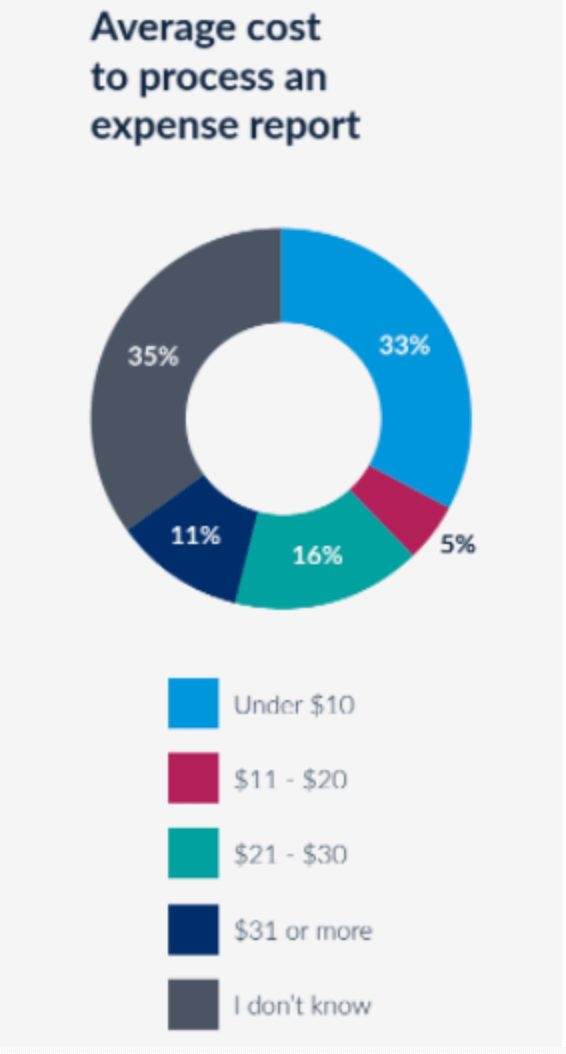
Additionally, many organizations are likely spending a lot more than they think to process expense reports.
The craziest part? Over 35% of organizations don’t know how much they’re paying to process expense reports. Without knowing their cost to process expense reports, it’s impossible for their T&E leaders to accurately identify opportunities for improvement.
One of the easiest ways to lower the cost of expense reports? Switch over to a monthly, subscription-based cloud T&E management solution that doesn’t charge per report. Pay a flat fee no matter how many expense reports you need to process (and easily forecast your cashflows).
6. Make more confident, data-driven spending decisions
What do improving productivity, lowering costs, and optimizing workflows all have in common? Automation, which can also be applied to your data. And the only time you can confidently make business and expense decisions are when you have supporting data.
Automated expense management systems not only make it easier for finance teams to collect reliable and accurate data 24/7, but they also free up valuable time that can be used to carefully analyze a clean, well-organized dataset to arrive at strategic, actionable insights that can drive consequential business decisions.
According to Egencia, in 2021 and beyond, the role of travel managers will continue to evolve. In fact, during the course of the pandemic alone, roles and responsibilities changed for 8 out of every 10 travel managers. And 3 out of 10 finance, procurement, and C-level executives said that while their focus on travel, in particular, was reduced, their jobs became far more strategic in general.
As travel demands pick up again, Deem believes that T&E departments should focus on specific initiatives to stay on top of the evolving workplace and ahead of the curve:
- Build up analytics capabilities: Business intelligence and data analytics improve visibility into employee travel and spending patterns, simplifying travel management. With reliable data insights, organizations can build more accurate financial models, budgets, and forecasts, which can lead to better business decisions.
- Manage increased risks: While travel risk management may not be front-and-center any more, expense-related risks are higher than ever. Remote work can make it easier for out-of-compliance spending to become an issue. Solutions that help travel managers assess and contain this risk (via real-time employee location data, for example) will be key to ensuring compliant spending.
- Monitor and prevent fraud: Wherever there is a risk of out-of-compliance spending, there is also the risk of business fraud. Predictive analytics solutions will only be more in-demand because it can help finance teams properly monitor and prevent fraud before it happens.
7. Upgrade your travel & expense management solution
The pandemic raised the stakes for organizations to scrutinize their spending more closely. Cash flow uncertainty made managing working capital effectively a business imperative in a fast-changing, potentially volatile business environment.
According to Emburse’s 2021 Travel & Expense Management Trends report, which surveyed thousands of finance leaders worldwide:
- 49% of organizations recently reviewed supplier/vendor payment terms.
- 46% of organizations recently reviewed customer payment terms.
- 20% of organizations recently changed suppliers.
Notably, companies with fewer than 50 employees were twice as likely to have reviewed payment terms with their vendors as larger companies. This is due in no small part to just how difficult it can be to achieve consensus at the enterprise or corporate level, especially when it comes to upgrading a legacy technology solution.
Maybe that’s why only one-third (36%) of all companies surveyed are still relying on manual processes or legacy solutions for T&E management. Think pen-and-paper workflows, Excel spreadsheets, outdated tech from the ‘90s, etc.
Nearly half of companies with 1,000+ employees still rely on manual input/homebrew systems or tacked-on expense modules within a larger ERP solution.
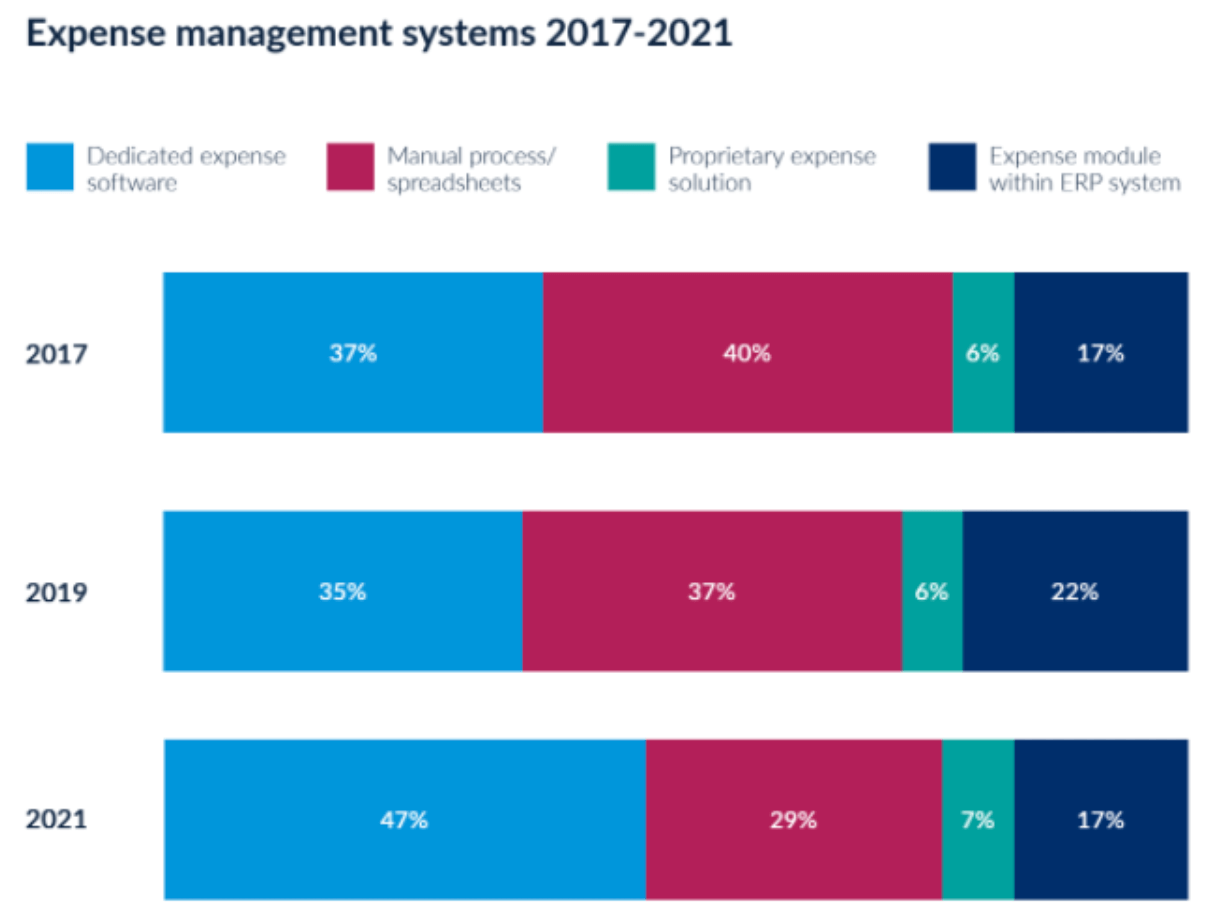
While enterprise-level companies are using cloud-based solutions or ERP applications for T&E management, they may be using outdated, legacy systems like SAP Concur, which was a best-in-class offering over 30 years ago.
It’s time to rethink Travel management
As pandemic variants spread and countries can’t decide whether to open or close their borders, life—and business—must go on. While experts don’t expect business travel bookings to return to pre-pandemic levels until 2025, T&E teams still have their work cut out for them. They should take this time to rethink their strategies and scale up what works best in a remote-first world.
The rise of remote and hybrid work models and conferences mean travel managers must rethink T&E policies altogether. They will spend less time planning how to get employees to in-person meetings, and more time determining the expected value of those meetings, all while justifying costs.
With fewer but more strategic business trips on the horizon, T&E teams can’t afford to waste time wrestling with outdated legacy technology. T&E leaders need flexible, 21st-century solutions that feature flexible, custom integrations, robust travel management options, and automated, mobile expense reporting and reimbursements.
Learn more in Part 2 of this series, where we’ll go over how current travel trends may impact the future of travel and expense management, and whether it’s the right time to revisit your current T&E management system.
Exceed your global organization’s travel requirements by partnering with Chrome River and your preferred travel vendors.
Search
Subscribe
Latest Posts
Posts by Category
Our choice of Chrome River EXPENSE was made in part due to the very user-friendly interface, easy configurability, and the clear commitment to impactful customer service – all aspects in which Chrome River was the clear winner. While Chrome River is not as large as some of the other vendors we considered, we found that to be a benefit and our due diligence showed that it could support us as well as any large players in the space, along with a personalized level of customer care.
We are excited to be able to enforce much more stringent compliance to our expense guidelines and significantly enhance our expense reporting and analytics. By automating these processes, we will be able to free up AP time formerly spent on manual administrative tasks, and enhance the role by being much more strategic.